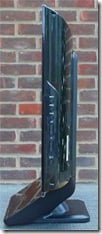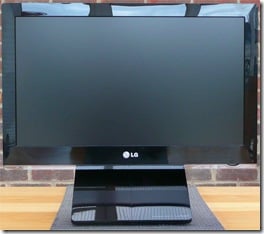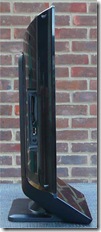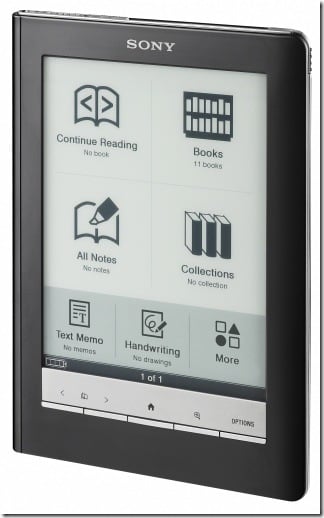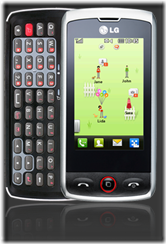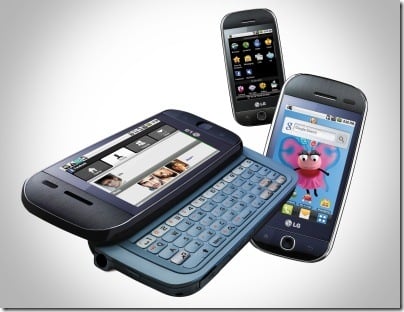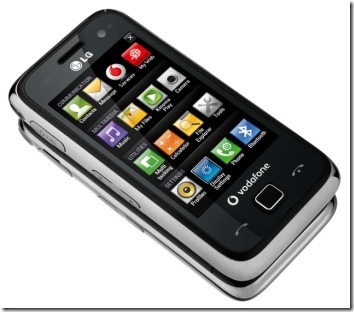
We recently got our hands on one of LG’s first Windows Mobile phones (in the UK anyway) in the form of the Vodafone exclusive GM750. Read on for the full review…
Overview
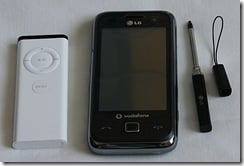
The GM750 is a mid-range smartphone with a 240×400 pixel resistive touch screen. It’s shown here with an Apple remote to give some sense of scale.
In the box you get a UK power adapter, telescoping stylus and earbud/headset.
The headline specifications are:
- Windows Mobile 6.5
- 240×400 screen
- 5 Megapixel camera
- MicroSD expansion
- 256MB on board memory
- A-GPS
- Video calling
- Bluetooth/Wifi/3G/HSDPA
In use
LG have skinned Windows Mobile with an approximation of the “S-class” UI found on their other phones. I’m in two minds about this skin – there are elements of it I like (such as the home screen) but on the whole I think I prefer the bare bones Windows Mobile look and feel. Luckily you get the choice so swapping between them is a matter of flipping an option in the settings screen.
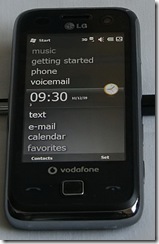
There are dedicated buttons for call start and end, volume and camera as well as one to bring up the task manager screen. The Camera and task manager buttons can be reassigned to other tasks if you prefer.
The 256MB on board RAM can be supplemented by a MicroSD card which is accessible without pulling the phone apart – handy for quick access to photos and mp3s.
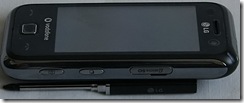
The center “button” on the face of the phone can be configured to act as a rather neat optical mouse or a 4 way “D-pad” (operated by swiping your thumb in the appropriate direction). I liked the D-pad option, it worked well and to a certain extent overcomes some of the limitations of the resistive screen.
The touch experience
LG make some superb capacitive touchscreens but sadly the one on the GM750 is a rather basic resistive model. It’s not the most sensitive of screens – it seems to respond well to the included stylus but finger (or fingernail) taps often don’t register.
That’s a shame as the design of the phone means there’s nowhere to store the stylus so you may well find yourself relying on fingers. The stylus is quite a chunky affair and while the size makes it quite comfortable to hold, it also makes it impossible to fit into the phone (or any phone come to think of it).
There is an on-screen QWERTY keyboard available if you want it – I’m not a fan of touchscreen keyboards in general but the GM750 does give you the option of using a “phone keypad” style interface with T9 which works well for all text input except URLs.
Extras
The phone includes tilt sensors which certain applications (Internet Explorer being the obvious one) use to automatically adjust their layout when you turn it sideways. It also has an onboard GPS which seems responsive and accurate.
You can use the phone as a bluetooth modem to a laptop – a nice bluetooth interface makes this fairly intuitive to set up.
Outlook contacts and calendar appointments sync up quite happily and you can download applications from the marketplace. In short, you get the full Windows Mobile experience.
WinMo is taking a beating in the popularity stakes at the moment with competition from Apple and Android but I have to admit to liking it – given that I use a Windows PC, the integration with the phone works for me.
Conclusion
The GM750 is a light, pocketable Windows Mobile phone which doesn’t have much direct competition. It’s free on a £25 contract with Vodafone at the time of writing which, for a decent WinMo smartphone, is pretty cheap.


 Email to a friend
Email to a friend Leave a comment
Leave a comment Share
Share